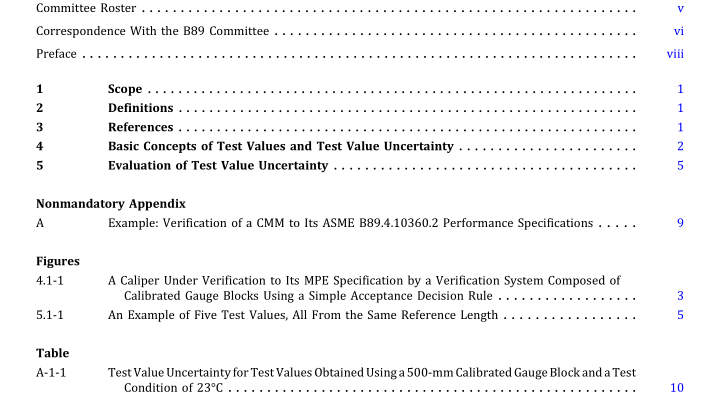ASME B89.7.6-2019 pdf free download.Guidelines for the Evaluation of Uncertainty of Test Values Associated With the Verification of Dimensional Measuring Instruments to Their Performance Specifications
This Standard provides guidelines for evaluating the uncertainty oftest values obtained when verifying dimensional measuringinstruments 1 to an ASME B89 testingprotocol.
The scope is limited to the case in which the testmeasurand is the error of indication at a rated operating condition; hence, test measurands such as the “worst possible” error of indication that might occur at any operating condition (including those conditions that are not tested) are outside the scope of this Standard.
ASME B89 testingprotocols are composed ofmanyindividual tests, each testyieldingone testvalue thatis an estimate of the instrument’s measurement error at the particular operating condition tested, and this test value is compared againstthemaximumpermissibleerror(MPE) (specifiedforthatratedoperatingcondition) usingtheprotocol’s decision rule. Although the MPE is specified by the instrument manufacturer for all rated operating conditions, the test value uncertaintyis associatedonlywith the testvalue obtained atthe particularoperatingcondition prevailingatthe moment the test value was obtained (unless a correction to the indication is performed that is allowed by the test protocol).
This issue is addressed by the standardization committee creating the testing protocol; the committee balances the number of tests against the amount of time and effort to complete the testing protocol.
The scope ofthis Standard excludes issues associated with the evaluation ofthe uncertainty offuture measurement results on workpieces and focuses solely on the test value uncertainties used to verify the instrument’s performance specification.
Typically, the testvalue uncertainty is much smaller than the associated MPE value ofthe verification test.
2 DEFINITIONS
The following definitions are specific to this Standard: instrument: the measuring system that is under verification to its performance specification.
NOTE: In this Standard, the term “instrument” is equivalent to “instrument under verification.” verification system: the measuring system that is used to verify an instrument to its performance specification.
NOTE: In this Standard, the verification system includes everything necessary to execute the testing protocol. This includes the calibrated reference quantity, equipment used in the transfer process, the human operator (if one is involved), computations and any other analysis needed, environmental and other conditions required by the instrument under verification, and any input quantities required to realize the measurand of the verification test.
3 REFERENCES
The following is a list of publications referenced in this Standard:
ASME B89.1.13-2013, Micrometers ASME B89.1.14-2018, Calipers
ASME B89.4.10360.2-2008, Acceptance Test and Reverification Test for Coordinate Measuring Machines (CMMs) — Part 2: CMMs Used for Measuring Linear Dimensions (Technical Report)
ASME B89.7.1-2016, Guidelines for Addressing Measurement Uncertainty in the Development and Application ofASME B89 Documents
ASME B89.7.2-2014, Dimensional Measurement Planning
4 BASIC CONCEPTS OF TEST VALUES AND TEST VALUE UNCERTAINTY 4.1 Introduction ASME B89 standards describe the testing protocols used to specifythe performance ofdimensional measuringinstru- ments. Verification of an instrument to its MPE is based on a decision rule (e.g., see ASME B89.7.3.1) that determines whether a test value (obtained per the testing protocol) is within its MPE specification. Theuncertaintyofaworkpiecemeasurement,havingameasurandsimilartothatusedin theASME B89 testingprotocolandobtainedwithintheratedconditions oftheinstrument, is primarilydeterminedbythe instrument’s MPE. In contrast, the testvalue uncertainty is associated with uncertainty ofthe testvalues obtained when verifying the MPE; it is independent of the MPE and hence has nothing to do with the accuracy of future workpiece measurements. An inaccurate instrument, with a large MPE, mighthave a relativelysmall testvalue uncertainty. |The test value uncertainty does not describe the accuracy of the instrument’s measurement results, but rather describes the accuracyofthe testvalues obtained in a verification test. Figure 4.1-1 illustrates the distinction between the instrument under verification that produces an error ofindication and the verification system that includes a calibrated reference quantity.ASME B89.7.6 pdf download.ASME B89.7.6-2019 pdf free download
